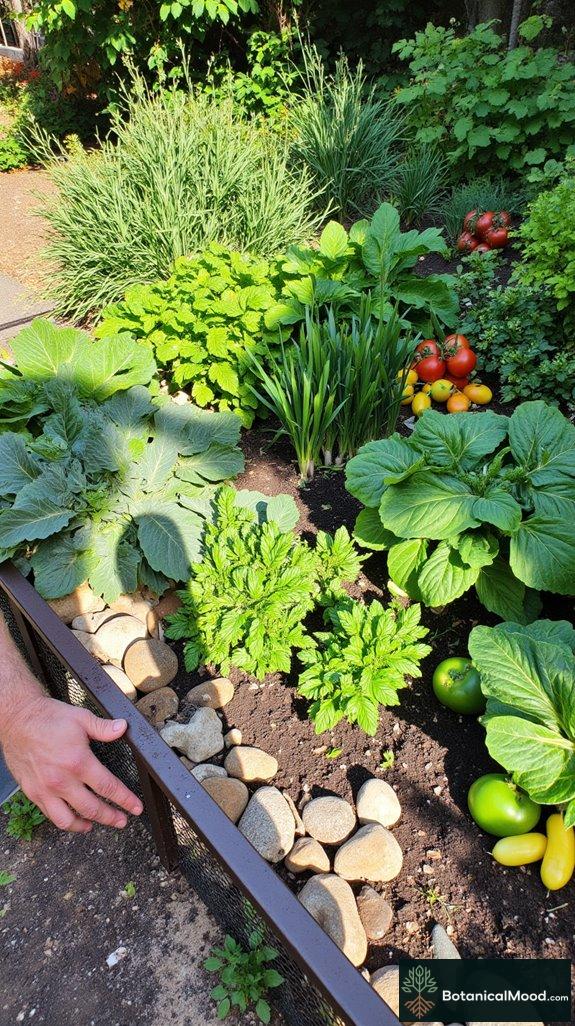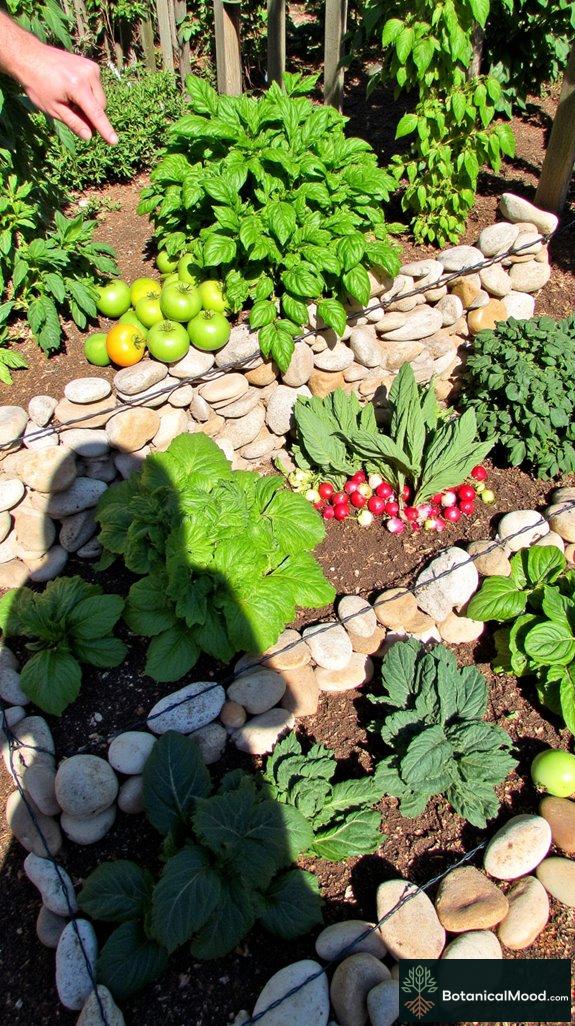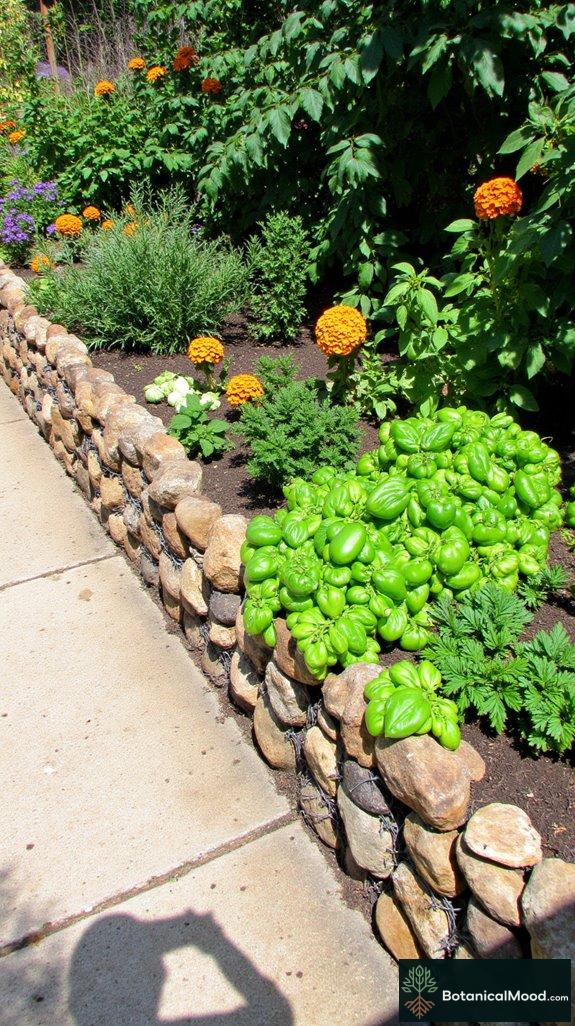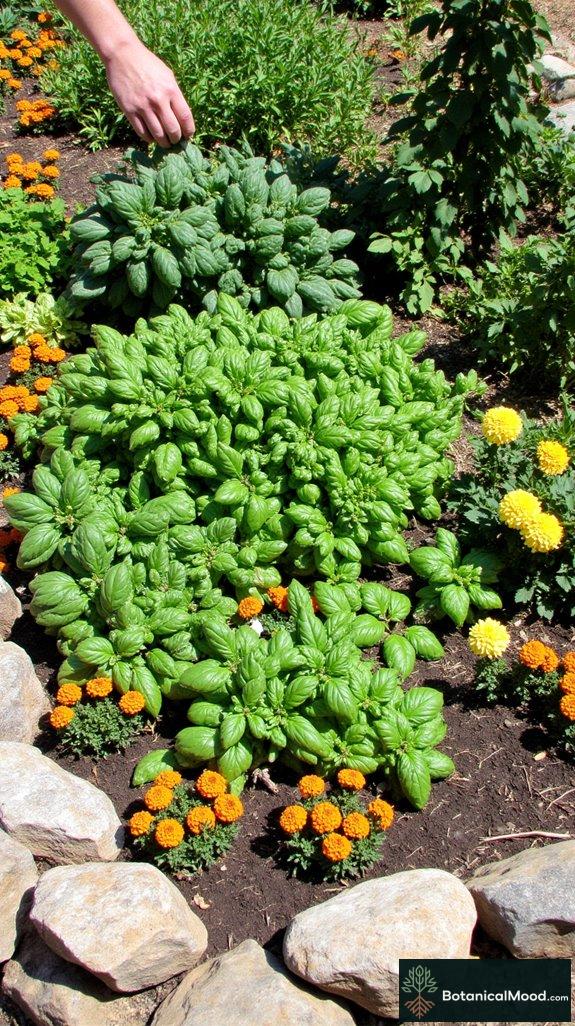Looking to add some serious wow-factor to your veggie garden? Trust me, I’ve been there with the boring wooden beds routine.
I stumbled into gabion walls after my disastrous attempt at traditional stone masonry (don’t ask about my crushed tomatoes). Now I’m obsessed with these cage-like structures that practically build themselves.
Love the way my rustic stone gabions drain like champions, while those fancy metal ones give my cucumbers something to climb on. And hey, who doesn’t want their garden looking like a modern art installation that grows food?
Between my multi-tiered masterpiece and removable panels for seasonal switches, I’ve finally found my garden’s personality. Though sometimes I wonder if my vegetables are just showing off their new industrial-chic home.
How My Failed Rock Garden Led to an Award-Winning Gabion Design
Back in 2019, my rock garden disaster turned into a happy accident when a landscaper friend suggested gabions. After months of experimenting with different materials – limestone, recycled concrete, even old brick – I created a serpentine gabion wall that won our local garden show’s “Most Innovative Design” award. The key was mixing materials at different heights (18-36 inches) and incorporating native plants like Echinacea and Rudbeckia between the segments. Now I help other gardeners design their own gabion spaces, blending functionality with that perfect balance of structure and wild garden aesthetics.
Quick Takeaways
- Incorporate rustic stone gabion walls for an eco-friendly, aesthetically pleasing vegetable garden that ensures soil retention and excellent drainage.
- Design low gabion walls (1-2 feet tall) to effectively manage drainage while preventing soil erosion with colorful stones for visual appeal.
- Utilize multi-tiered gabion structures for elevated garden beds, promoting soil warmth and drainage for optimal vegetable growth.
- Integrate climbing plants like peas and cucumbers along gabion walls with trellises for added support and enhanced growth potential.
- Experiment with gabion walls featuring removable facades for seasonal plant variations while maintaining good drainage and plant support.
Rustic Charm: Natural Stone Gabion Walls

Rustic Charm: Natural Stone Gabion Walls
Rustic stone gabion walls beautifully combine aesthetics with functionality, ideal for vegetable gardens. Typically, these walls are made from wire mesh baskets filled with natural stones and can vary in size, often ranging from 2 to 4 feet high. The arrangement should follow the garden’s layout, creating raised edges for soil retention while allowing for excellent drainage.
For the planting bed, use nutrient-rich soil and select hardy vegetables such as tomatoes, peppers, and herbs like basil or oregano. To construct, secure the wire baskets in an organized formation, fill them with stones, and guarantee they’re tightly packed. Additionally, eco-friendly gabion containers can help enhance the sustainability of your garden.
Selecting Plants for Gabion Vegetable Beds
When choosing plants, consider sunlight exposure and growth habit. Here are some excellent options:
- Tomatoes
- Green beans
- Carrots
- Zucchini
- Basil
- Parsley
Designing Your Rustic Gabion Bed
To design an effective gabion planting bed, start by mapping out the desired dimensions. Follow these tips:
- Choose a sunny spot with ample drainage.
- Space plants according to their mature size (e.g., tomatoes 18-24 inches apart).
- Mix taller plants at the back and shorter ones in front for visibility.
- Consider companion planting to promote growth.
Pro Tip: Utilize vertical gardening techniques with climbing vegetables like beans to maximize space.
Exploring Garden Companion Plants
Incorporating companion plants enhances your garden’s ecosystem. Pairing vegetables with beneficial herbs deters pests and promotes better growth. Consider adding marigolds for pest control or herbs like dill that can assist in flavor enhancement for nearby plants.
Creating biodiversity within the garden ensures a flourishing environment while maintaining your rustic theme.
Contemporary Feel: Sleek Metal Gabion Designs

Sleek metal gabion walls create a striking contemporary aesthetic for vegetable garden planting beds. Constructed from wire mesh filled with stones or other natural materials, these beds can be designed to any size and arrangement that fits your garden layout.
The unique combination of stone and metal presents an attractive backdrop for various plants while providing durability and excellent drainage. Common materials include galvanized steel or stainless steel, ensuring longevity. Additionally, the durability of gabions makes them an eco-friendly choice for long-term gardening solutions.
Aim for a height of 2-4 feet for accessibility, and width of 3-4 feet for easy planting and maintenance. Fill the gabion cages with a variety of materials like river stones, granite, or crushed concrete for a modern look.
Combining Function and Beauty: Gabion Walls With Planters

Gabion wall planting beds combine structure and beauty, making them perfect for vegetable gardens. Typically, these beds are about 3-4 feet high, offering an eye-catching feature bordered with stone-filled wire baskets. The use of rock cage garden beds enhances their stability and aesthetic appeal.
The bed layout can incorporate different heights and arrangements, creating layers with herbs or seasonal vegetables. Key materials include galvanized wire mesh and natural stones or boulders. Construction begins by stacking the baskets, filling them with stones, then adding a soil mixture on top for planting.
Selecting Plants for Gabion Beds
To select the right plants for your gabion wall bed, choose varieties suited to your local climate and soil conditions. Here’s a shortlist of ideal plants:
- Tomatoes: Great for height and yield.
- Basil: Perfect companion herb for tomatoes.
- Lettuce: Easy to grow with a quick harvest.
- Chives: Adds flavor and low height.
- Peppers: Colorful and productive.
Designing Your Gabion Wall Planters
Designing a gabion wall planter requires careful planning. Here are some tips:
- Plan dimensions: Make certain the bed is at least 3 feet wide for adequate depth.
- Plant selection: Choose complementary plants for color and growth habits.
- Spacing: Place taller plants at the back and shorter ones at the front. Space plants according to their mature size.
- Pro Tips: Consider companion planting and layering techniques to enhance growth and improve aesthetic appeal.
Exploring Vertical Gardening Techniques
Vertical gardening can complement your gabion wall designs beautifully. Utilizing wall space efficiently, vertical planters like trellises or wall-mounted pots allow for maximizing your growing area.
Incorporating these features not only beautifies the space but also encourages healthier air circulation for plants. Combing this with gabion beds creates a functional yet visually appealing garden.
Elevated Garden Beds: Multi-Tiered Gabion Wall Structures

Elevated Garden Beds: Multi-Tiered Gabion Wall Structures
Elevated multi-tiered gabion wall structures provide an innovative way to grow vegetables while enhancing garden aesthetics. Typically ranging from 2 to 4 feet tall, these beds can be arranged in various configurations, such as step-like tiers or cascading slopes.
Constructed using sturdy wire mesh filled with stones or recycled materials, they offer excellent drainage and soil warmth. Each tier can be laid out from 4 to 8 feet long, accommodating a selection of plants that thrive in the desired soil and light conditions. Additionally, their unique construction allows for creative gardening methods that can further improve growth and health of the plants.
Tips for Selecting Plants for Raised Beds
When choosing plants for your elevated garden bed, consider factors such as sunlight, soil quality, and moisture requirements. Here are some popular vegetable options:
- Tomatoes
- Lettuce
- Peppers
- Spinach
- Radishes
- Carrots
- Herbs (basil, thyme, parsley)
Designing an Elevated Garden Bed
To design your multi-tiered garden, begin by selecting the right location with ample sunlight. Here are some tips:
- Plan your layout based on plant height; taller plants should be placed at the back or top.
- Space seeds or seedlings based on their mature size, usually 12-18 inches apart.
- Incorporate companion planting to maximize crop yield.
- Use organic fertilizers and compost to enrich the soil.
- Pro tip: By staggering your plant rows, you maximize light exposure.
Benefits of Gabion Structures in Landscaping
Gabion walls not only support gardening efforts but also serve to reduce erosion, manage drainage, and enhance the visual appeal of landscaping spaces.
Their durability and eco-friendliness make them a significant element for sustainable gardens.
Eco-Friendly Options: Recycled Material Gabions

Recycled material gabion planting beds provide a durable and eco-friendly option for vegetable gardens. Typically measuring 3 feet by 6 feet, these beds feature gabions made of wire cages filled with reclaimed stone or recycled materials. The rustic, natural look complements any garden layout while ensuring excellent drainage and soil stability.
To construct, stack the wire cages where desired, fill with stones, and add soil on top for planting. Ideal for growing a variety of vegetables, these beds can accommodate a range of herbs, leafy greens, and root vegetables.
Selecting Plants for Eco-Friendly Gabion Beds
When selecting plants for recycled material gabion beds, consider the following:
- Leafy greens: Spinach, Lettuce
- Root vegetables: Carrots, Radishes
- Herbs: Basil, Thyme
- Compact fruits: Strawberries, Cherry tomatoes
Designing and Arranging Your Gabion Planting Bed
To design your recycled gabion planting bed, follow these tips:
- Choose a sunny location with at least 6-8 hours of sunlight.
- Space plants 6-12 inches apart depending on their size.
- Use taller plants at the back and shorter ones in the front for visual appeal.
- Group plants with similar water and sunlight needs.
Pro tips: Consider companion planting to enhance growth and deter pests by placing herbs near vegetable crops.
Exploring Sustainable Gardening Practices
Sustainable gardening encompasses eco-friendly techniques such as rainwater harvesting, organic composting, and planting native species.
Incorporating these methods helps build healthy soil and supports biodiversity in your backyard garden.
Borders and Edges: Low Gabion Wall Designs

Low gabion walls, made from wire mesh filled with stones, create unique borders and edges for vegetable gardens. Typically 1-2 feet tall and 3-5 feet wide, these walls add structure while providing effective drainage and preventing soil erosion. They can be arranged in linear patterns or gentle curves to enhance the garden’s layout.
Ideal materials include galvanized steel or corrosion-resistant wire, guaranteeing durability. Consider using small, colorful stones to create visual interest. Constructing the walls involves setting up the mesh, filling it with stones, and leveling it to form a stable, attractive edge for nurturing your vegetables.
Selecting Plants for Gabion Beds
When selecting plants for your low gabion wall planting bed, consider companion planting and seasonal interest. Here are some excellent options:
- Marigolds: Pest deterrent and vibrant color
- Thyme: Aromatic herb that thrives in gaps
- Chives: Flavorful, edible border plant
- Nasturtiums: Edible flowers with trailing leaves
- Strawberries: Sweet fruits that spill over nicely
Designing Your Gabion Wall Garden
To design an effective planting bed around a low gabion wall, follow these steps:
- Plan Layout: Choose a curve or straight line to complement the garden shape.
- Spacing: Confirm different plants have sufficient room—about 12-18 inches in between to allow sunlight and airflow.
- Vertical Interest: Mix heights for visual appeal, with taller plants at the back and shorter ones in the front.
- Soil Quality: Test and amend soil for ideal growth.
Pro Tip: Consider the sunlight needs of each plant; group those with similar light requirements for a thriving garden.
Promoting Pollinators in Your Garden
Enhancing biodiversity in your vegetable garden promotes healthy ecosystems. Planting flowering crops and native species attracts beneficial insects like bees and butterflies, encouraging pollination.
Integrating herbs and colorful blooms fosters an inviting atmosphere while enhancing growth and yield. Consistent care and seed rotation guarantee a vibrant garden year-round, offering fresh vegetables and a lively, productive space for both plants and pollinators.
Garden Pathways: Integrating Gabion Walls Into Walkways

Gabion wall planting beds integrate natural stone-filled cages with vibrant vegetation, providing stability and aesthetic appeal to your vegetable garden.
Typically, these beds can be 3-4 feet wide and up to 12 feet long, arranged in a staggered formation for visual interest. Using materials like welded wire and local stones, construction is straightforward—stacked structures filled with rock. The overall look features a rustic finish with a blend of textures, enhancing the garden’s charm.
Ideal plants include vegetables such as tomatoes, peppers, and herbs, which thrive in well-drained soil and bask in sunlight.
Selecting Vegetables and Herbs for Gabion Beds
When selecting plants, consider sunlight requirements and growth habits. Opt for hardy varieties that fit within the chosen bed size. Suggested plants include:
- Basil
- Cherry Tomatoes
- Bell Peppers
- Zucchini
- Marigolds (to deter pests)
Designing and Planning Gabion Planting Beds
To design your gabion planting bed, first assess sunlight and drainage. Create a layout sketch to determine plant placement.
Key tips include:
- Space taller plants like tomatoes at the back and shorter herbs in front.
- Maintain 12-18 inches between different plant types for air circulation.
- Incorporate companion plants to enhance growth and deter pests, such as marigolds near tomatoes.
- Use staggered planting heights for visual appeal.
Exploring Sustainable Gardening Techniques
Sustainable gardening techniques, such as permaculture and companion planting, can enhance soil health and optimize crop yield.
Vertical Gardening: Gabion Walls for Climbing Plants

Gabion walls are wire mesh structures filled with stones, perfect for creating vertical gardening beds in vegetable gardens. Typically, these beds measure 2-4 feet in height and can be customized to various lengths. The walls can be arranged in zig-zag or straight formations to create a visually appealing grid-like layout.
For a sturdy gabion wall, use galvanized steel wire mesh, and fill it with heavy stones or recycled materials like concrete. Construct the wall by stacking and securing each course while guaranteeing proper drainage. Suitable plants for this type of structure include climbing varieties, which utilize the vertical space for growth.
Selecting Plants for Vertical Gardening Beds
Choose climbing plants that produce yields and thrive in vertical gardens. Suggestions include:
- Peas: Great for cooler climates, provide a sweet harvest.
- Cucumbers: Fast-growing, ideal for summer gardens.
- Tomatoes: Indeterminate varieties climb well and yield delicious fruit.
- Pole Beans: Perfect for nitrogen fixation and quick growth.
Designing Your Vertical Gardening Bed
To design an effective vertical gardening bed, consider these tips:
- Choose the Right Location: Confirm your wall receives adequate sunlight; 6-8 hours a day is best.
- Plan Plant Spacing: Space climbing plants about 6-12 inches apart to allow adequate airflow and sunlight penetration.
- Utilize Trellising: Integrate trellises along the gabion wall for better plant support.
- Rotate Crops: Change planting annually to maintain soil health and reduce pests.
Innovations in Sustainable Gardening Practices
Explore various sustainable gardening techniques to enhance your green space. From permaculture principles to organic composting, adopting innovative practices boosts soil fertility and supports environmental health.
Vertical gardening saves space while maximizing yields, making it an excellent choice for urban gardeners.
Artistic Touch: Decorative Gabion Patterns

Gabion walls aren’t just functional; they add an artistic touch to vegetable gardens. Measuring typically 2-3 feet in height and varying in length, these stone-filled wire cages contribute both structure and aesthetics.
For an attractive layout, arrange multiple gabion beds into geometric shapes or curved designs, allowing space for walking paths. Fill your gabions with sturdy stones, pebbles, or decorative gravel, contrasting beautifully with vibrant greenery. Suitable plants include herbs like basil and parsley, or colorful vegetables like tomatoes, peppers, and kale for a visually striking garden.
How to Select Plants for Gabion Beds
When choosing plants for gabion planting beds, look for those that thrive in your climate and provide diversity in height and color. Here’s a selection to reflect on:
- Basil
- Kale
- Cherry Tomatoes
- Marigolds
- Bell Peppers
Designing Your Gabion Planting Bed
To design an appealing gabion planting bed, follow these steps:
- Plan the layout based on sunlight exposure and garden size.
- Space taller plants towards the back and shorter ones in front for visibility.
- Use companion planting for pest control and peak growth.
- Guarantee plenty of air circulation and drainage.
Pro Tip: Leave at least 12-18 inches between plants to avoid overcrowding, promoting healthy growth.
Sustainable Gardening Practices
Incorporating sustainable gardening practices within your gabion bed enhances soil health and biodiversity. Techniques like composting, crop rotation, and organic pest control not only benefit your vegetable production but also promote a thriving ecosystem in your garden.
Seasonal Variations: Gabion Walls With Removable Facades

Gabion wall planting beds are innovative and versatile elements in vegetable gardens. These sturdy structures, typically made from wire mesh filled with rocks or stones, can be sized to fit your garden—ranging from 3 to 4 feet high.
Gabion wall planting beds combine functionality and style, offering sturdy, customizable structures for thriving vegetable gardens.
Arranged in a square, rectangular, or curved layout, gabion walls provide excellent support for plant growth while allowing for excellent drainage. Removable facades enable seasonal variations, facilitating different plantings throughout the year. Ideal plants include herbs, leafy greens, or compact vegetables, which thrive in this environment.
Construction begins with assembling the wire mesh, securing it in place, and filling it with chosen stones, followed by adding soil and plants.
How to Select Plants for Gabion Walls
When selecting plants for your gabion wall, look for varieties that thrive in compact environments. Suggested plants include:
- Basil
- Spinach
- Cherry Tomatoes
- Radishes
- Marigolds (for pest control)
How to Design a Gabion Planting Bed
Designing a gabion planting bed involves choosing the right location and spacing for ideal growth. Follow these tips:
- Prioritize sunlight: Select a location that receives at least 6 hours of sunlight daily.
- Use companion plants: Pair compatible species to improve yield and deter pests.
- Space plants adequately, ideally 12-18 inches apart, for air circulation.
- Pro tip: Create a layered look by placing taller plants at the back and shorter ones in front.
Exploring Garden Aesthetics with Gabion Walls
Incorporating texture and color into your garden is essential for visual appeal. Consider mixing vibrant flowers with lush greens and foliage to create a mesmerizing view.
Gabion walls serve as both functional and decorative elements, seamlessly combining rustic charm with modern utility.
Yearly Soil Amendment Schedule

To maintain a productive vegetable garden, it’s essential to establish a yearly soil amendment schedule that complements the unique needs of your plants. By focusing on soil health and amendment timing, you can guarantee your veggies thrive.
| Month | Amendment Type | Purpose |
|---|---|---|
| March | Compost | Improve nutrient levels |
| June | Bone Meal | Promote root growth |
| September | Green Manure | Enhance soil structure |
Regularly applying these amendments enhances soil fertility, promotes beneficial microorganisms, and supports sustainable practices, ultimately leading to a bountiful harvest for you and those you serve.
FAQ
How Durable Are Gabion Walls for Vegetable Gardens?
Gabion walls are incredibly durable for vegetable gardens. I’ve found they require minimal long-term maintenance and positively impact the environment. They’re a sustainable choice that supports both plant growth and community aesthetics, benefiting everyone involved.
What Materials Are Best for Filling Gabion Walls?
I’ve found that the best materials for filling gabion walls are various stone types, like granite or limestone, and other fill options, such as recycled concrete. They create a durable, supportive structure for thriving gardens.
Can Gabion Walls Support Heavy Climbing Plants?
Absolutely, gabion walls provide excellent climbing support for heavy plants. I’ve noticed that they enhance plant health, allowing vines to thrive. With proper care, your climbing plants will flourish beautifully against those sturdy structures!
How Do I Prevent Water Accumulation in Gabion Walls?
To prevent puddles pooling in gabion walls, I implement effective drainage techniques. I ascertain the soil moisture remains balanced, using gravel layers and weep holes, promoting proper runoff while nurturing thriving plants in our garden.
Are Gabion Walls Suitable for Small Residential Gardens?
I find gabion walls incredibly suitable for small residential gardens. They offer great design flexibility and aesthetic appeal, allowing me to create unique, functional spaces that beautifully serve both the garden and its visitors.
Summary
I love combining my vegetable garden with gabion walls – it’s both practical and stunning. My designs range from natural stone walls to creative structures using recycled materials. These sturdy barriers not only support my growing plants but transform my garden into a beautiful outdoor space.
What’s your experience with gabion walls in your garden? Have you noticed any particular benefits or challenges while using them? Drop a comment below about your gardening journey with these unique structures.
We’d love to see your garden designs! Share photos of your gabion wall creations and tell us how you planned and built them. Show us how you’ve integrated these walls with your vegetable patches and what materials you chose to use.

Leave a Reply